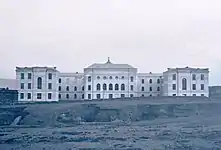Vake
ვაკე | |
|---|---|
Neighborhood of Vake District | |
 High-rise residential and office buildings on Ilia Chavchavadze Avenue | |
Interactive map outlining Vake border | |
| Country | |
| City | Tbilisi |
| District (Raioni) | Vake District[1] |
| Part of Tbilisi since | 1906 |
| Demonym | Vakeli (Georgian: ვაკელი) |
| Time zone | UTC+4 (Georgian Time) |
| Postal code | 0179 [2] |
Vake (Georgian: ვაკე [vɑkʼɛ]) is a neighbourhood in southwestern part of Tbilisi, Georgia,[3] on the right bank of the river Mtkvari; it is part of Vake District.
The name originated in the 19th century, meaning a plain or flat place. Vake is a settlement that originated on the territory of Old Vera. By the beginning of the 20th century, its borders were: to the east Varaziskhevi, to the north – Vere River, south and southwest – mountain skirts. During this period, the development of Tskneti Street (now Petre Melikishvili Street) reached Varaziskhevi with a small bridge over it. In Tbilisi Development plan of 1906 only the Nobility Gymnasium building is mentioned in this area (currently 1st building of Tbilisi State University). Then Tbilisi Spiritual Seminary was built not far from the gymnasium (later on this building became agricultural institute, now it is one of the clinics of Tbilisi State Medical University [formerly the 9th Hospital]).
Since January 1906, Vake was incorporated into Tbilisi. Intensive construction began in the 1920s. For a long time, this neighbourhood was connected to the center of Tbilisi only by Melikishvili Street. In 1957, as a result of reconstruction of the lower part of Varaziskhevi, it became connected to Heroes Square. In 1958, Vake-Saburtalo Connection Highway (currently Mikheil Tamarashvili Street) was also constructed. Today, Vake is one of the most prestigious areas for living in Tbilisi. Most of central Vake is flat, has two big parks, and a lot of restaurants and cafes.[4]
The border starts from Heroes Square and goes up the axis of Varaziskhevi Street, crosses Ilia Chavchavadze Avenue, then passes along the axis of Kekelidze Street in Varaz gorge and follows the gorge to the head, where it turns right and goes in the north-west direction, crosswise. In the back (abundant) gorge gorge, on the left it leaves the Kaklebi summer settlement and from the Bagebi to the Kaklebi settlement it connects to the Tbilisi-Tskneti highway, follows this highway to the extreme north-west curve and connects directly to the Tbilisi administrative border, to the left.
Vere to the top of the northern watershed ridge, from where the border joins the Tbilisi-Nafetvari road to University Street, then follows University Street to the intersection of Tamarashvili Street. From where the border runs along Tamarashvili Street in a south direction for 450 meters. Then the border turns east and follows the river. Vere watershed at a distance of 1300 meters, from where the border crosses the river. In the Vere riverbed and continues to the Heroes Square.[5]
Currently, Vake is one of the largest residential areas of Tbilisi. There are also high schools, research centers, administrative institutions, etc. In 1946, Vake Park was opened (formerly Victory Park, Architect K. Dgebuadze, Dendrologist N. Tsitsishvili). In 1982, Children's park and recreation park Mziuri was opened.
Gallery
 Tbilisi State University building in 1918
Tbilisi State University building in 1918 Tbilisi State University main campus
Tbilisi State University main campus Chavchavadze Street in 2004
Chavchavadze Street in 2004 Central Fountain
Central Fountain

See also
Bibliography
- Georgian Soviet Encyclopedia V4, p. 274, Tbilisi, 1979.
- Kvirkvelia, T., Old Tbilisi Settlements, pp. 36–37, Tbilisi, 1985.
References
- ↑ "Ქ. თბილისის მუნიციპალიტეტში დადგენილ ადმინისტრაციულ საზღვრებში არსებული ადმინისტრაციული ერთეულების - რაიონების ტერიტორიულ ერთეულებად – უბნებად დაყოფის შესახებ".
- ↑ Find a postal code gpost.ge
- ↑ "A Complete Neighborhood Guide to Tbilisi". theculturetrip.com. Culture Trip. 12 April 2018. Retrieved 21 May 2020.
- ↑ "Living in Tbilisi Georgia – A Complete Neighborhood Guide". expathub.ge. 8 March 2021.
- ↑ "Ქ. თბილისის მუნიციპალიტეტში დადგენილ ადმინისტრაციულ საზღვრებში არსებული ადმინისტრაციული ერთეულების – რაიონების ტერიტორიულ ერთეულებად – უბნებად დაყოფის შესახებ".